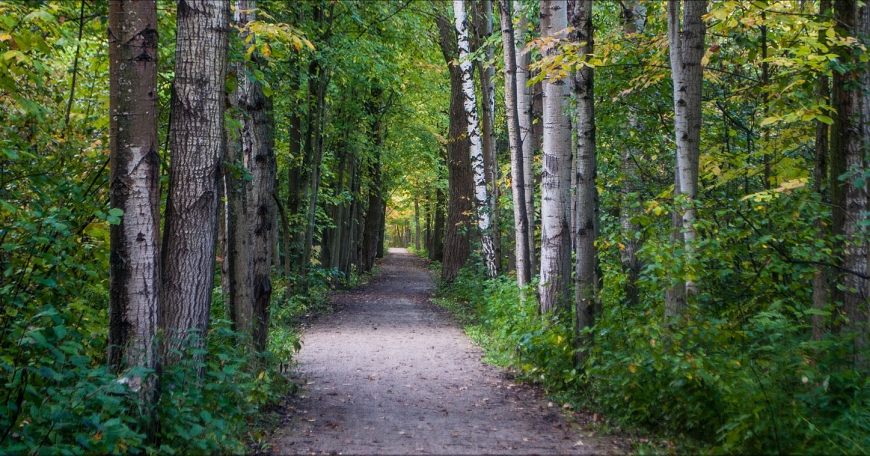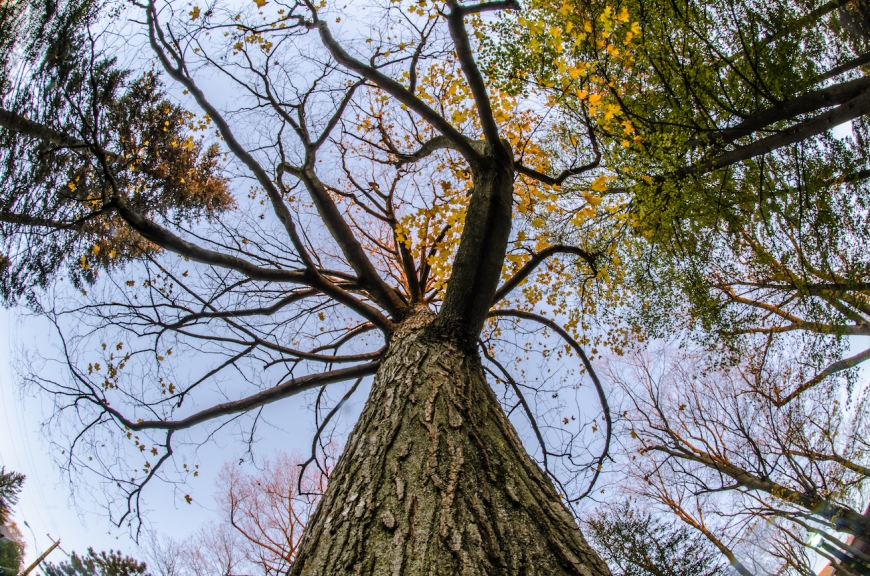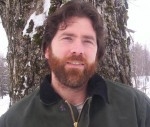

Aspen and birch species, such as those seen lining this trail, are among the first to regenerate a new forest. Photo: JJ Losier, Creative Commons
Sugar maples are long-lived species. Photo: David Pynchon


Forest Succession: A Living Symphony
Senescence is the decline in vigor that happens to all creatures great and diminutive as they close in on the life expectancy of their species. People my age suddenly find they require reading glasses to see the phone book. Though I suppose by definition anyone still using a phone book is old enough to need glasses, right?
The onset of this process varies—you probably know of families whose members frequently retain good health into their 90s, and other families where that is not the case. Of course environment is important. Eating and sleeping well, cultivating gratitude, and laughing a lot will help keep us healthier longer. But there comes a point at which even the best-preserved specimen can’t avoid the end of life.
Trees also go through senescence at different rates. Each species has an approximate lifespan after which no amount of TLC can keep them alive. One of the more popular white-barked birches for landscape planting is the native gray birch. You may love your birch clump, but those trees are old at thirty years, ancient at forty—by the time they double over and kiss the ground in heavy snow or an ice storm, they may be on their way out anyway.
Many of us are aware poplars are short-lived as a genus. Lombardy poplar, an import, barely makes it out of its teens. Trembling aspen is usually decrepit at fifty, but its close cousin bigtooth aspen might reach eighty, and eastern cottonwoods, our largest poplar, can live more than a hundred years. Pin cherry declines after twenty to thirty years, but black cherry lives much longer, often more than a hundred. Paper birch in a good location (i.e., not in a landscape setting) may approach 80 or 90.
At the other end of the spectrum are oaks. Bur oak is a massive and picturesque tree which can live eight centuries or more. White oak has similar potential. By comparison, red, pin and black oaks are lightweights, rarely living past four hundred. Beech trees, close relatives of oaks, can also live hundreds of years. Unfortunately, a tiny invasive scale insect coupled with a native fungus are killing beech before they reach mature size. Sugar maples and hickories are other long-lived species.
With a few exceptions, short-lived tree species tend to be shade-intolerant, and are usually pioneer, or early succession, trees. In temperate parts of the world with decent rainfall, just about every piece of open land wants to become a forest.
But woods go through many phases as they move toward a stable system. Succession is the permutation of woodlands as they mature from a beaver meadow or pasture to an endpoint, or climax, community. Once the beavers’ pond drains as they move to better feeding grounds, or the farm field is abandoned, a natural order of plant life begins to shape the landscape like a living symphony.
The first trees on the scene are often the fast-growing poplars, whose cottony seeds fly many miles. Birch pips, airy and papery as insect wings, blow in as well. White-footed mice cache pin cherry seeds; deer deposit hawthorn and viburnum in their droppings. As the new canopy matures at seventy feet and blocks out the sky, the forest floor becomes too shady for poplar and cherry seedlings to survive.
Into our intrepid pioneer forest of birch, poplar, cherry and hawthorn fly the helicopter samaras (winged seeds) of sugar, soft, and striped maples. Red squirrels cache acorns and conifer seeds. These are long-lived, shade-tolerant species. Seeds germinate, and saplings bide their time in the understory, sometimes for decades, waiting for senescence to play out.
Forty years on, many pioneer trees are in decline, and succumb to insects, stem cankers, root rots, or storm damage. Every time a trembling or bigtooth aspen goes down, a patch of sunlight illuminates the forest floor, allowing a patient, shade-tolerant maple, oak or hemlock to quickly stretch for the sky.
Eventually a stable mix of long-lived, relatively shade-tolerant trees develops -- a climax community. The species composition will vary depending on elements such as soil type, slope and climate. Elders will topple every so often, allowing the youngsters a chance at the sun, but the makeup of the forest will remain roughly the same until the next ice age, bulldozer or beaver dam wipes the slate clean.
Neither person nor plant can avoid senescence, which has the same Latin root, senex, or old, as senility. In that sense I envy trees. The decline of individual trees is a critical part of the forest life cycle, and they don’t have to worry about remembering where they left the car keys, or the car for that matter.

